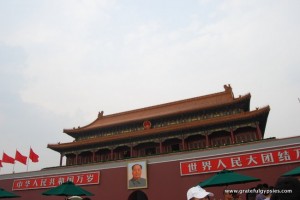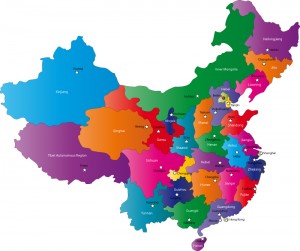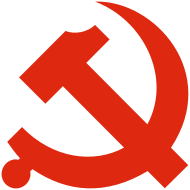The Middle Kingdom Posted by sasha on Jun 3, 2012 in Culture, Uncategorized, Vocabulary
So you want to learn Chinese, huh? Well, if you’re going to learn a language, you might as well learn something about the country, too. I’m going to be ripping off Stephen Colbert and his “Better Know a District” segment a little bit, as I roll out “Better Know a Province,” a new series here on the Transparent Language Chinese blog. But before we get down into the details of each specific province in China, let’s step back and take a look at the entire country and some useful Chinese words associated with it:
- Official Name: The People’s Republic of China (中华人民共和国 – zhōng huá rén mín gòng hé guó) – The official name of the country, the PRC, is not commonly used, but if you were wondering what the characters were on the entrance to the Forbidden City, now you know. In full, it reads, “Long live the People’s Republic of China” (中华人民共和国万岁 – Zhōng huá rén mín gòng hé guó wàn suì) on the left, and “Long live the world’s peoples” (世界人民大团结万岁 – shì jiè rén mín dà tuán jié wàn suì).

The gate to the Forbidden City.
- Shortened Name: China (中国 – zhōng guó) – Literally translated, the Chinese name for China is “middle country.” This is why China is known as the Middle Kingdom.
- Geographical Makeup: China is composed of 22 provinces, five autonomous regions, four municipalities, and two special administrative regions. Sound confusing? It is… This will be touched on more in the coming posts.
- Population: Over 1.3 billion (十三亿 – shí sān yì) – China remains the most populated country on Earth, although India is catching up. Thanks to China’s One Child Policy, India will most likely surpass it within a matter of years.
- Ethnic Groups: 56 – A majority of the Chinese population are Han Chinese (汉人 – hàn rén) – about 92% – and there are also 55 ethnic minority groups (少数民族 – shǎo shù mín zú).
- Capital: Beijing (北京 – Běi jīng) – While this city has been the Chinese capital a few times throughout China’s long history, its most recent ascension to the position came on October 1, 1949, when Mao Zedong proclaimed the founding of the PRC with Beijing as its center.
- Official Language: Mandarin Chinese (普通话 – pǔ tōng huà – lit. “common speech”) – While Mandarin may be the official language of China, there are a variety of accents and dialects throughout this massive country with its diverse population. Of course, in Hong Kong, people speak Cantonese (广东话 – guǎng dōng huà).
- Government: Communist (共产 – gòng chǎn) – While it’s getting harder and harder to really describe China’s government in one word, this one is still the most common. However, these days many politicians prefer to go with the description “socialism with Chinese characteristics.”
- Ruling Party: Communist Party of China (中国共产党 – zhōng guó gòng chǎn dǎng) – After countless dynasties and a long and bloody civil war, the Communist Party eventually took control of China in 1949 and hasn’t looked back since.
- National Anthem: “March of the Volunteers” (义勇军进行曲 – yì yǒng jūn jìn xíng qǔ) – China’s national anthem has a long and confusing history. For the full story, check the Wiki page here. In the meantime, here are the lyrics in Chinese characters:
起來!不願做奴隸的人們!
把我們的血肉,築成我們新的長城!
中華民族到了最危險的時候,
每個人被迫著發出最後的吼聲。
起來!起來!起來!
我們萬眾一心,
冒著敵人的炮火,前進!
冒著敵人的炮火,前進!
前進!前進!進!
And here’s a video, with the pinyin and English:
- Flag: 5-Star Red Flag (五星红旗 – wǔ xīng hóng qí) – This flag was first hoisted over Tiananmen Square on October 1, 1949 with the founding of modern day China. The red color represents the revolution and the blood spilled during it. The largest star represents the Communist Party, and the four smaller stars surrounding it represent the Chinese people, as categorized by Chairman Mao – the working class, the peasantry, the urban bourgeoisie and the national bourgeoisie. These four stars are all aligned around the bigger star, and they point directly at it, signifying unity throughout the country.
- National Emblem: Depicting the image of the Gate of Heavenly Peace – or Tiananmen (天安门 – tiān’ān mén) as it’s better known – the national emblem is also red and yellow, and also contains the stars of the flag.
- National Holidays: In China, there are seven official public holidays – New Year, Spring Festival, Tomb Sweeping Day, Labor Day, Dragon Boat Festival, Mid-Autumn Festival, and National Day.
Check back here in the months to come for more in depth looks at the various areas of this huge country, as we discuss the people, the landscape, the culture, the food, and much, much more! In the meantime, make sure you’re learning at least one word every day with our Chinese word of the day page.

Build vocabulary, practice pronunciation, and more with Transparent Language Online. Available anytime, anywhere, on any device.
About the Author: sasha
Sasha is an English teacher, writer, photographer, and videographer from the great state of Michigan. Upon graduating from Michigan State University, he moved to China and spent 5+ years living, working, studying, and traveling there. He also studied Indonesian Language & Culture in Bali for a year. He and his wife run the travel blog Grateful Gypsies, and they're currently trying the digital nomad lifestyle across Latin America.








Leave a comment: